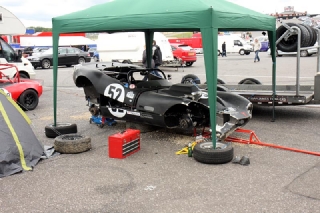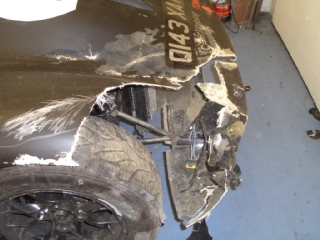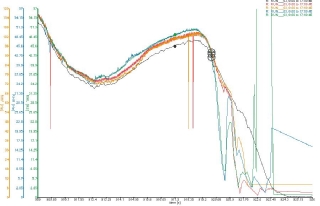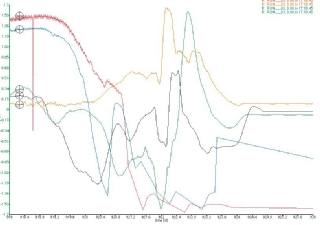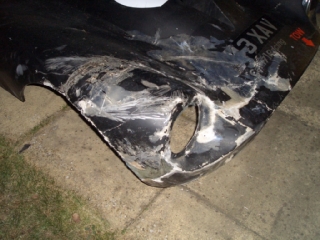I think it's fair to say that my weekend's racing did not go to plan.
In fact, I didn't end up doing any racing at all, due to the fact that I crashed the car while testing on the Friday.
And, indeed, crashed it pretty thoroughly. So the continutation of Operation Finish The Bloody Race was hindered
by an unexpected failure to complete Operation Start The Bloody Race. The run-up to testing was standard enough
- get trailer from garage, load it up, load up the car, sleep, get up early and head down to Brands. The run down
was grey and drizzly but the circuit was dry and the overcast skies didn't seem particularly threatening. The first
session was spoiled somewhat by yet another bloody braking problem - this time the problem was that I had to pump
the brakes up for every corner, which is quite annoying and rather distracting.
I knew what the cause of this was - when I'd reassembled the uprights after my upright-machining adventures, I'd
done it as per the workshop manual - tighten the bearing nut to 27lbft while rotating the hub, then back off 90
degrees. Every time I've tried this previously it's ended up with the wheel bearings being too loose, and this
time was no exeption - they were allowing the hubs and brake disc to wobble around, backing the pads off the discs.
That was the main braking problem during the first session, but even after I'd pumped the brakes up they didn't
feel exactly reassuring. I'd fitted Polymatrix A brake pads to replace the Smart pads I'd fitted earlier. These
have a much higher co-efficient of friction and should in theory provide more effective brakes. However, I was
finding that they were so aggressive that they were snatching the brakes left, right and centre and it was almost
impossible to modulate them - as soon as you even squeezed the brake pedal they just snatched. The car felt deeply
unstable under braking, which isn't exactly ideal when your aim is to increase your apex speeds...
During the one hour break between the first and second sessions, I tightened up the wheel bearings and with that
done headed out back onto the track. The long pedal issue had largely gone, but the brakes still didn't feel great.
Still, they were working, and my lap times were coming down as I started pushing harder, getting back into the
1:54s which I'd managed last time out. Indeed, I could see Phil Alcock, a class C RGB driver, ahead of me and I
was clearly reeling him in. However, before I closed up with him, things went rapidly and quite seriously wrong.
I was driving up the hill towards Druids, and had started braking in the usual place - just at the bridge over
the circuit. Just after I'd started braking, the car suddenly snapped left and started spinning. The front right
corner hit the Armco on the left hand of the circuit, which slammed the rear right corner into the Armco, and I
ended up nearly completing the 360 degree turn in the gravel. To the right of me there was still tarmac - I'd barely
got past the apex of the corner during the entire crash. It was fairly obvious from the loud bangs that the car
was going to be rather worse for wear. Indeed, the rather jaunty angle at which the front right wheel was lying
meant that the suspension and steering linkages had given up the unequal struggle to stay intact. The medical staff
asked me if I was OK, I reassured them I was, and the recovery chaps got the car on the low-loader and returned
both me and it to the paddock.
To quote, Captain Slow himself, Oh cock...
Wheels locked up a 88mph, hit barrier at 47mph - scrubbed some off under braking and while pirouetting along track... |
|


